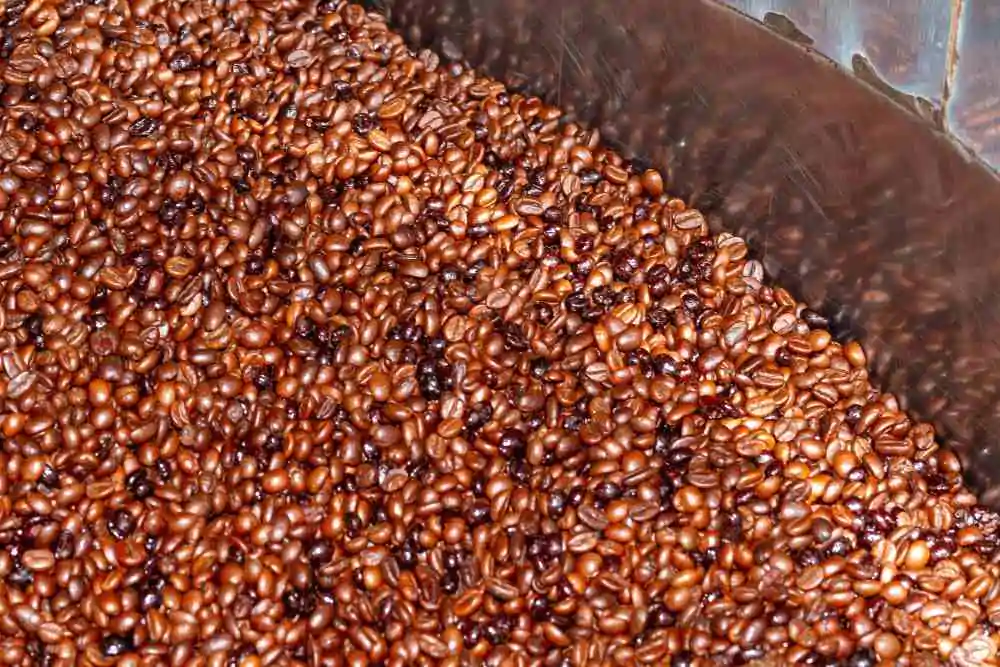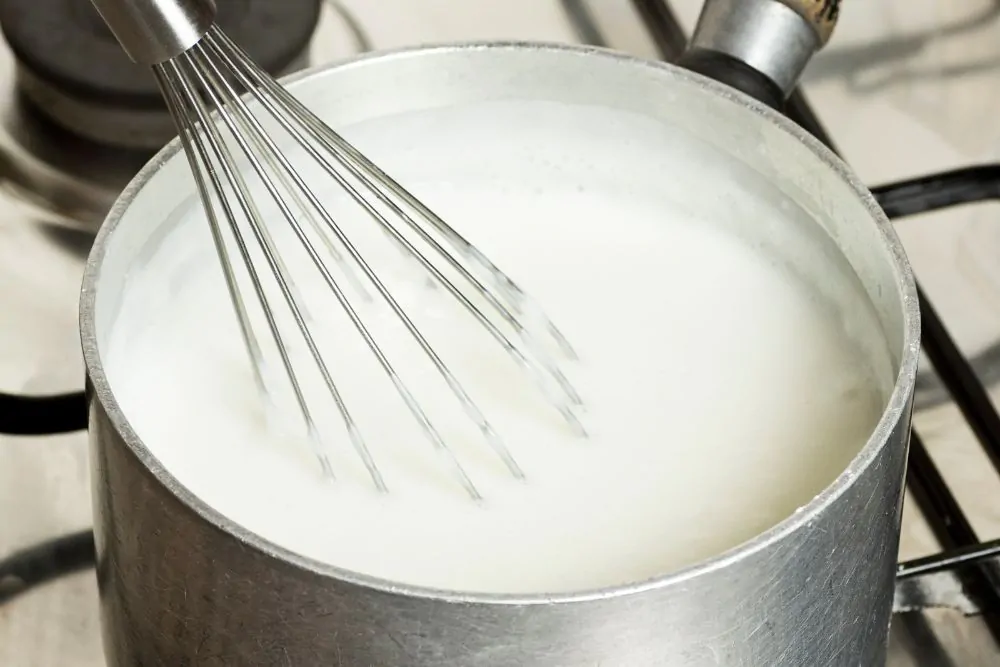If you want something sweeter than a latte but not as rich as a mocha or flavored coffee drinks, Spanish coffee may be for you, but what is a Spanish latte?

The beautiful thing about coffee is it can reflect the tastes of a culture; Turkish and Vietnamese coffee is incredibly strong, while drip coffee is the beverage of choice in the United States. Naturally, Spain has developed its own twist on coffee.
The Spanish latte is a small coffee drink made from espresso, scalded milk, and sweetened condensed milk or sugar. This beverage is steadily gaining popularity elsewhere; the use of condensed milk makes it sweet but not as decadent as a mocha or flavored latte. It still allows the robust coffee flavors to shine without feeling too overpowering.
You might be interested in our round-up of the best Spanish coffee brands.
What Is A Spanish Latte?
The Spanish latte is known as café con leche in Spain, which means coffee with milk. The combination of scalded milk and sweetened condensed milk is what sets it apart from other drinks.
For comparison, a regular latte is made from espresso, steamed milk, and a thin layer of milk foam. There is a 1:3 ratio of coffee to milk in a standard latte.
The Café Au Lait, which is French for coffee with milk, is a mixture of drip coffee and steamed milk. In the US, scalded milk is often used instead. The New Orleans spin on the drink combines coffee, chicory, and scalded milk.
A Spanish latte combines equal amounts of espresso with scaled milk, followed by two teaspoons of sweetened condensed milk or sugar.
Scalding milk was initially a method of killing bacteria, but it’s since entered the coffee world as the process makes the milk flavor stronger. The texture is creamy, but it lacks the air bubbles found in steamed milk. This allows a Spanish latte to have a rich mouthfeel.
The strong coffee flavors and luscious texture make a Spanish latte more satisfying than a regular latte in the morning.
History Of Spanish Lattes
Coffee is a big part of the culture in Spain. Spaniards socialize in cafés with small cups of coffee and watch the world go by.

Spanish coffee drinkers love strong coffee, so if you get this latte in Spain, you’ll likely notice a smokey taste. Coffee used to be preserved by adding sugar during the roasting process, which burnt, turning the beans black.
The black coat helped reduce oxidation, so the coffee tasted fresh for longer periods. This became known as torrefacto coffee. While this preservation method is no longer necessary since these days, airtight coffee storage containers are commonplace, Spaniards grew to like the flavor, so it has endured.
Torrefacto coffee isn’t a necessity when brewing a Spanish latte, but it’s worth a try. Not every coffee shop will use these beans, so ask your barista in advance. The smokey coffee flavors contrasted with the creamy condensed milk make for a more complex-tasting drink.
The Spanish latte is typically enjoyed as a breakfast drink. Although it’s small, the scalded milk and sweetened condensed milk are dense enough to make it filling. As it’s so decadent, people rarely drink multiple cups throughout the day.
The exact origins of this beverage are unclear, but it’s believed to have been inspired by Vietnamese coffee. Classic Vietnamese java is a combination of drip coffee and sweetened condensed milk. One of the main differences is that Robusta coffee is the coffee of choice in Vietnam, largely because it’s grown there, whereas Spaniards are more likely to use Arabica.
You might be familiar with Café Bombon too. Although this drink originated in Spain and took inspiration from Vietnam, it is not the exact same as a Spanish latte. Also known as bon bon coffee, this beverage is an espresso shot topped with sweetened condensed milk.
Health Benefits Of Spanish Lattes
Coffee has many health benefits; one of the perks of caffeine is improved memory and mental function, helping you to feel alert and ready for the day ahead. Drinking coffee is also a way to consume antioxidants, which may lower your risk of developing ailments, like certain cancers or heart disease, and can reduce premature aging.
Milk is a good source of protein, vitamin D, calcium, and many more vital vitamins and minerals. However, scalded milk will contain fewer nutrients, in particular, the B vitamins. Condensed milk will still retain some of the benefits of milk, but the additional calories are concerning.
For health-conscious coffee lovers, the calorie content of a Spanish latte will depend on whether you brewed it with sugar or sweetened condensed milk and how much of these ingredients were used. Most people drink this beverage because they enjoy it and not because they’re trying to reap any potential benefits. With that said, let’s have a look at the nutritional breakdown.
Two teaspoons of sweetened condensed milk contains 41 calories and 6.9 grams of sugar. The same amount of table sugar would add 33 calories to your drink and 8.4 grams of sugar.
Scalding milk doesn’t alter the calorie content. Using two ounces of milk to match two espresso shots will add 31 calories and 3.1 grams of sugar. Espresso essentially has no calories or sugar.
A Spanish latte will have around 72 calories and ten grams of sugar if it is brewed using sweetened condensed milk, while a drink made with sugar will total 64 calories and 11.5 grams of sugar.
A small standard latte (8 ounces) contains 94.5 calories and 9.5 grams of sugar. Although this might seem like a lot compared to the figures above, a Spanish latte is only 4.33 ounces. So, when looking at these drinks, ounce-per-ounce, a regular latte will be lower in sugar and calories.
It’s not advised to consume more than 50 grams of added sugar per day, which is the equivalent of 12 teaspoons, but there’s nothing wrong with treating yourself every now and then.
How To Make A Spanish Latte At Home

Materials Needed
Equipment:
- Espresso machine or alternative coffee brewer
- Pot or microwave-safe container
- Small glasses
- Thermometer
Ingredients:
- Two espresso shots
- Two ounces of scalded milk
- Two teaspoons of sugar or sweetened condensed milk
- Cocoa powder (optional)
Step 1: Prepare The Scalded Milk
You can scald milk on the stove or in a microwave, but the stove is the best option as it’s easier to monitor the temperature. When scalding milk, it cannot reach boiling point, 212°F, and must be cooled a little before using it for coffee.
Since the amount of milk used in a Spanish latte is so small, you must scald more than necessary to prevent it from drying up. Ideally, at least a cup.
If you’re using a stove, pour the milk into a pot on medium heat. Stir the milk regularly to prevent skin from forming on the top, and cook it until it reaches 180°F and then remove from the heat.
To scald milk in the microwave, pour it into a microwave-safe container and heat it at 20-second intervals. You’ll have to stop the microwave and check the temperature continuously.
You can try to scald plant-based milk alternatives, but the results will not be the same as they do not contain the same proteins and fats as cow’s milk. This could ruin the taste or cause coagulation.
Step 2: Brew The Coffee
After scalding the milk, brew your espresso as normal. If you don’t have an espresso machine, you can use a pod brewer, a Moka pot, or an Aeropress to achieve similar results.
Step 3: Combine The Ingredients
Although it’s not a requirement, Spanish lattes are usually served in clear glasses so you can see the layers. Pour two ounces of scalded milk into a cup, followed by two espresso shots.
Then top with condensed milk or add sugar. White sugar is the norm, but you can use brown sugar for a more caramel-like flavor.
Step 4: Garnish & Enjoy
Feel free to garnish with a dash of cocoa powder, stir, and enjoy your drink.
The Final Word
Spain doesn’t get the same acclaim in the coffee-drinking world as the likes of Italy and France, but it shouldn’t be overlooked. With innovations like torrefacto and bon bon coffee, Spanish java is a must-try for coffee connoisseurs.
The Spanish latte, in particular, is a delightful, comforting drink that will make waking up in the morning just that little bit easier. Its popularity has continued to grow as it can satisfy those with a sweet tooth. This drink can also help new coffee drinkers grow accustomed to the more intense flavor of coffee as the sweetened condensed milk takes the edge off.
If you want to broaden your coffee horizons, try a Spanish latte at home or see if your local barista can whip one up.
